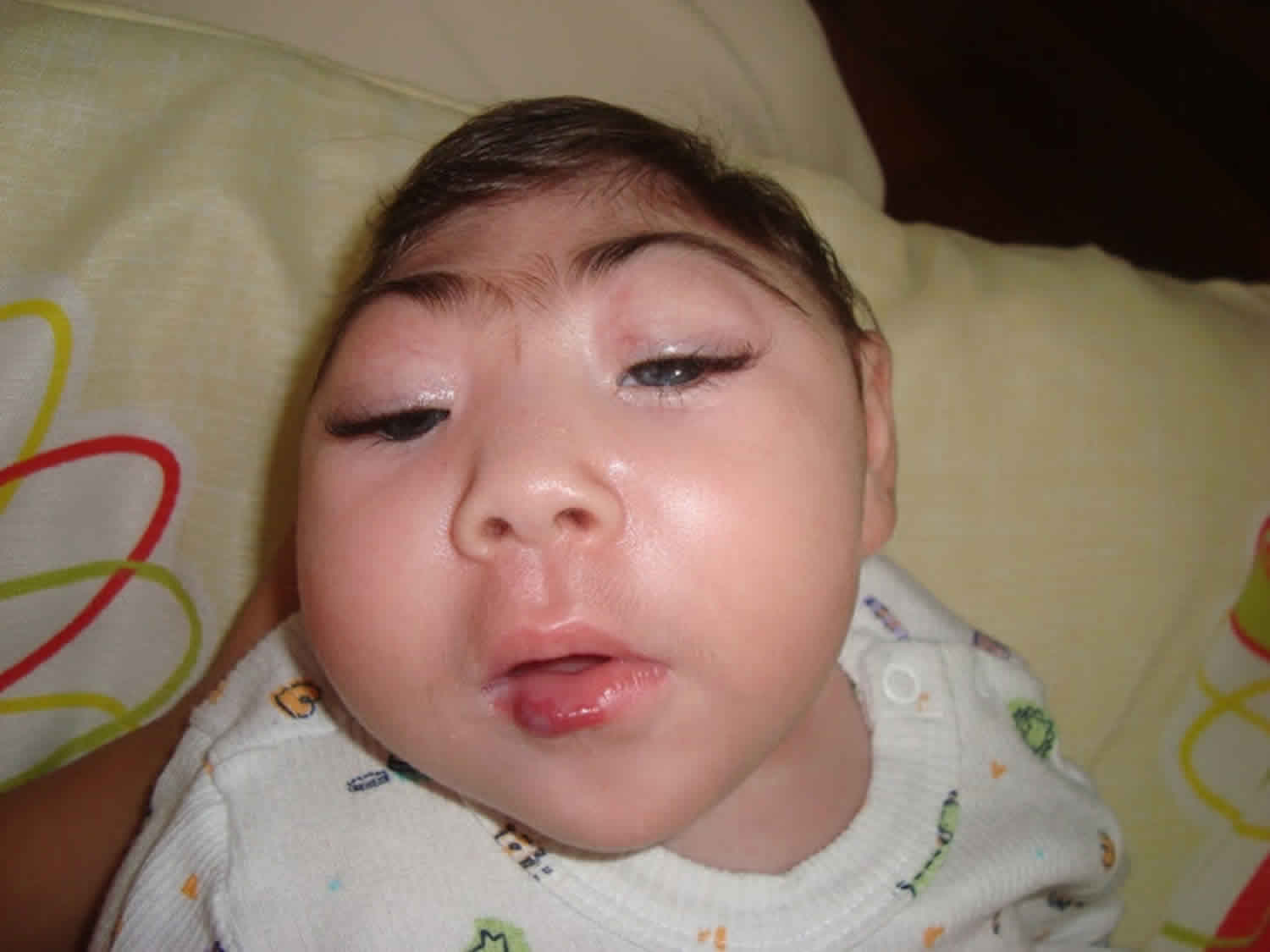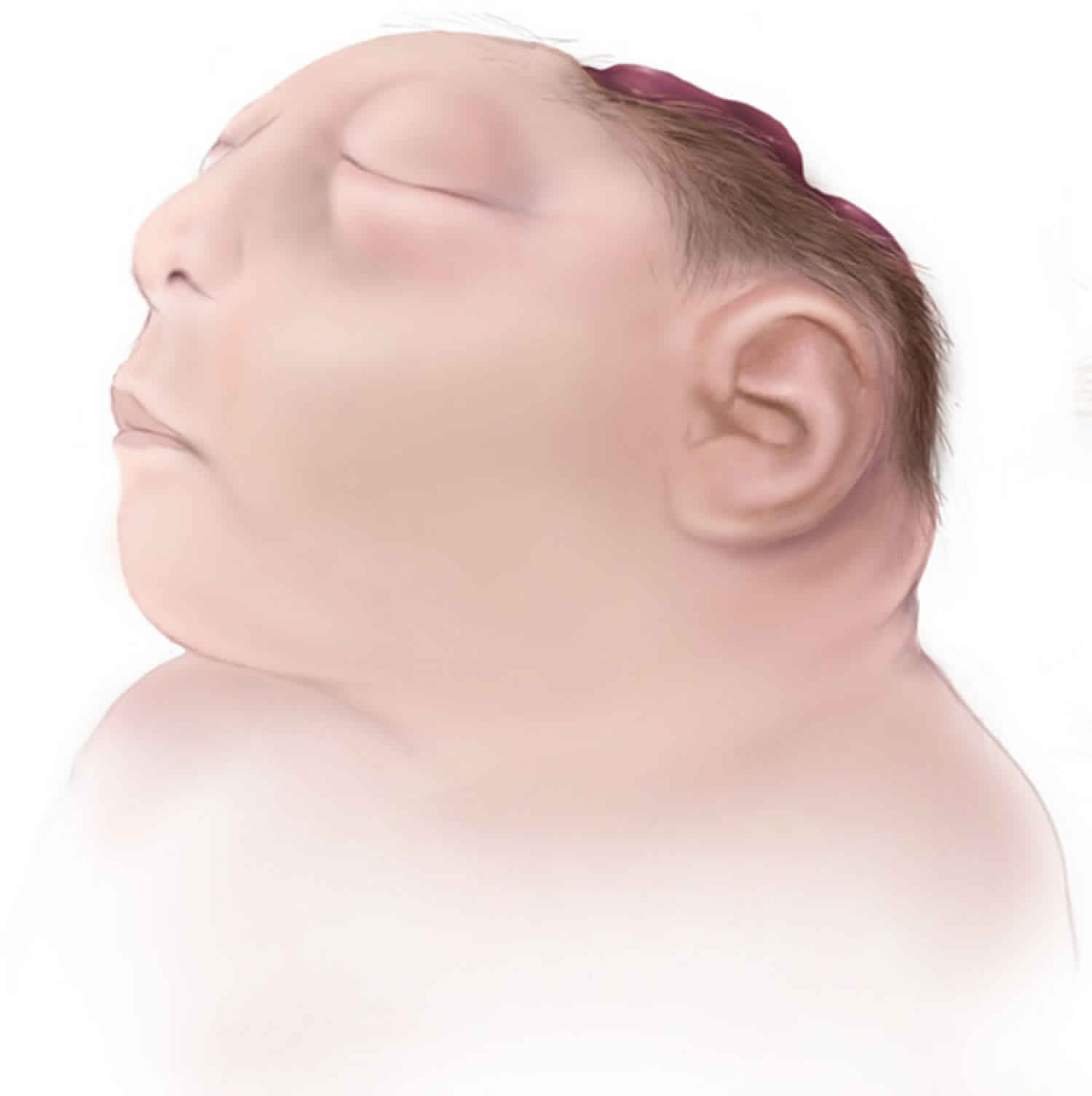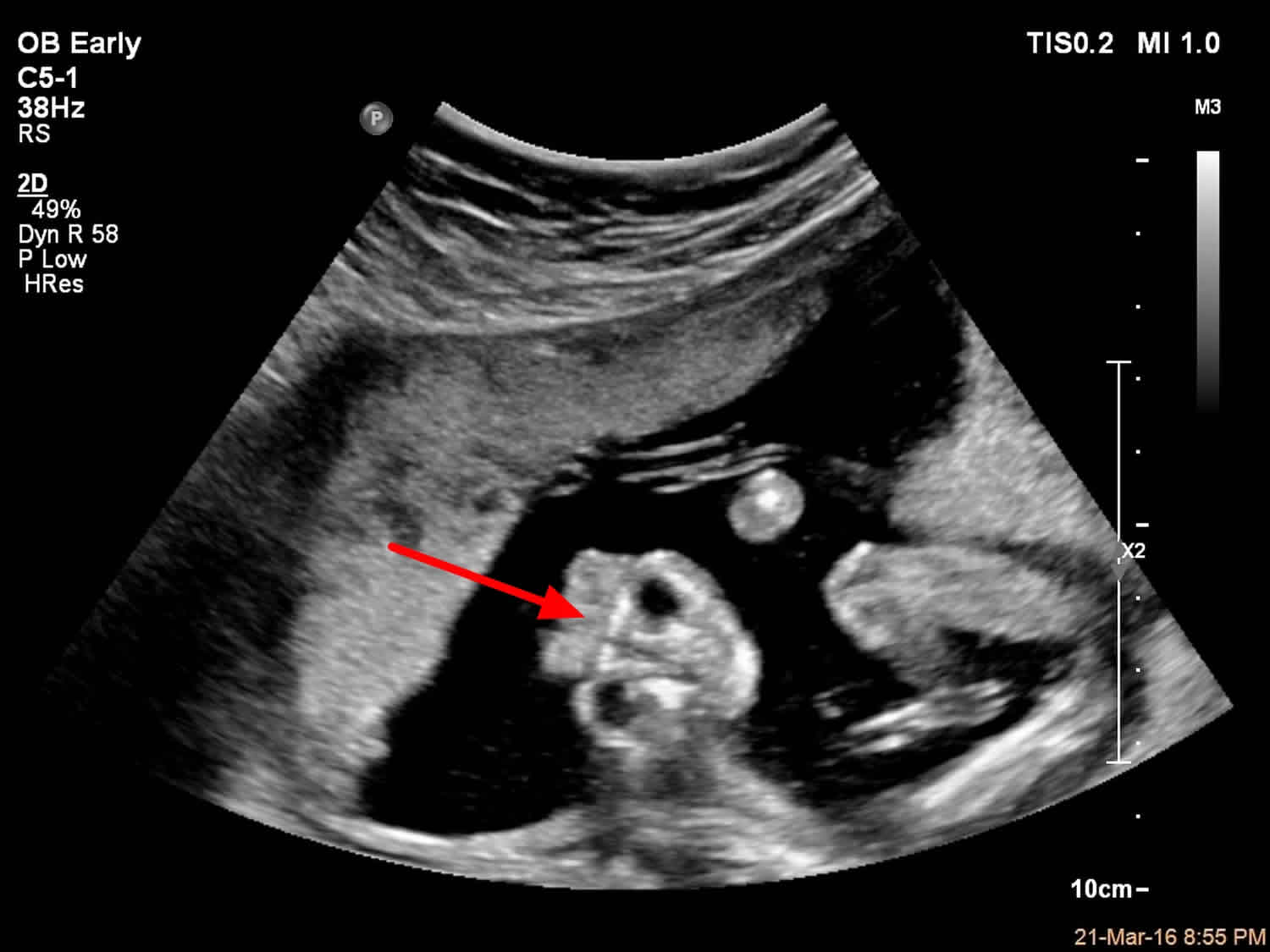What is anencephaly
Anencephaly is a term that refers to the incomplete development of the brain, skull, and scalp and is part of a group of birth defects called neural tube defects. Anencephaly is one of the most common neural tube defects. Neural tube defects are birth defects that affect the tissue that becomes the spinal cord and brain.
Anencephaly occurs early in the development of an unborn baby. Anencephaly results when the upper part of the neural tube fails to close. This often results in a baby being born without the front part of the brain (forebrain) and the thinking and coordinating part of the brain (cerebrum). The remaining parts of the brain are often not covered by bone or skin.
Why this happens is not known. Possible causes include environmental toxins and low intake of folic acid by the mother during pregnancy.
The exact number of cases of anencephaly is unknown, because many of these pregnancies result in miscarriage. The Centers for Disease Control and Prevention (CDC) estimates that each year, about 3 pregnancies in every 10,000 in the United States will have anencephaly 1. This means about 1,206 pregnancies are affected by these conditions each year in the United States 2. Having one infant with anencephaly increases the risk of having another child with neural tube defects.
There is no known cure or standard treatment for anencephaly. Almost all babies born with anencephaly will die shortly after birth.
Figure 1. Anencephaly
How many babies are born with Anencephaly?
Researchers estimate that about 1 in every 4,600 babies is born with anencephaly in the United States 3.
Anencephaly causes
The causes of anencephaly among most infants are unknown. Some babies have anencephaly because of a change in their genes or chromosomes. Anencephaly might also be caused by a combination of genes and other factors, such as the things the mother comes in contact with in the environment or what the mother eats or drinks, or certain medicines she uses during pregnancy.
During pregnancy, the human brain and spine begin as a flat plate of cells, which rolls into a tube, called the neural tube. If all or part of the neural tube fails to close, leaving an opening, this is known as an open neural tube defect. This opening may be left exposed or covered with bone or skin.
Anencephaly and spina bifida are the most common open neural tube defects, while encephaloceles (where there is a protrusion of the brain or its coverings through the skull) are much rarer. Anencephaly occurs when the neural tube fails to close at the base of the skull, while spina bifida occurs when the neural tube fails to close somewhere along the spine.
Open neural tube defects happen to couples without a prior family history of these defects in the vast majority of cases. open neural tube defects result from a combination of genes inherited from both parents, coupled with environmental factors. For this reason, open neural tube defects are considered multifactorial traits, meaning many factors, both genetic and environmental, contribute to their occurrence.
Once a child has been born with an open neural tube defect in the family, the chance for an open neural tube defect to happen again is increased by 4 to 10 percent. It is important to understand that the type of neural tube defect can differ the second time. For example, one child could be born with anencephaly, while the second child could have spina bifida.
Getting enough folic acid before and during early pregnancy can help prevent neural tube defects, such as anencephaly. If you are pregnant or could get pregnant, take 400 micrograms (mcg) of folic acid every day. If you have already had a pregnancy affected by an neural tube defect, you can speak with your doctor about taking a higher dose of folic acid before pregnancy and during early pregnancy.
- Since the United States began fortifying grains with folic acid, there has been a 28% decline in pregnancies affected by neural tube defects (spina bifida and anencephaly) 1
- In order to get the recommended 400 micrograms of folic acid every day, a woman of reproductive age can take a supplement containing folic acid or to eat foods fortified with folic acid, or both, depending on her dietary habits.
Anencephaly prevention
There is good evidence that folic acid (vitamin B9) can help reduce the risk of certain birth defects, including anencephaly. Women who are pregnant or planning to become pregnant should take a multivitamin with folic acid every day. Many foods are now fortified with folic acid to help prevent these kinds of birth defects.
Getting enough folic acid can cut the chance of neural tube defects in half.
Folic acid can help reduce the risk of certain birth defects, such as spina bifida and anencephaly.
- Women who are of childbearing age should take at least 400 micrograms (mcg) of a folic acid supplement every day in addition to that found in fortified foods.
- Pregnant women should take add 600 micrograms a day, or 1000 micrograms a day if expecting twins.
Folic acid is available in multivitamins and prenatal vitamins, supplements containing other B-complex vitamins, and supplements containing only folic acid. Common doses range from 400 to 800 mcg in supplements for adults and 200 to 400 mcg in children’s multivitamins 4.
About 85% of supplemental folic acid, when taken with food, is bioavailable 5. When consumed without food, nearly 100% of supplemental folic acid is bioavailable.
Table 1 lists the current Recommended Dietary Allowances (RDAs) for folate as mcg of dietary folate equivalents (DFEs). Recommended Dietary Allowance (RDA) is the average daily level of intake sufficient to meet the nutrient requirements of nearly all (97%–98%) healthy individuals; often used to plan nutritionally adequate diets for individuals.
The Food and Nutrition Board of the Institute of Medicine developed dietary folate equivalents (DFEs) to reflect the higher bioavailability of folic acid than that of food folate. At least 85% of folic acid is estimated to be bioavailable when taken with food, whereas only about 50% of folate naturally present in food is bioavailable 6. Based on these values, the Food and Nutrition Board defined dietary folate equivalent (DFE) as follows:
- 1 mcg DFE = 1 mcg food folate
- 1 mcg DFE = 0.6 mcg folic acid from fortified foods or dietary supplements consumed with foods
- 1 mcg DFE = 0.5 mcg folic acid from dietary supplements taken on an empty stomach
Factors for converting mcg DFE to mcg for supplemental folate in the form of 5-methyl-THF have not been formally established 7.
For infants from birth to 12 months, the Food and Nutrition Board of the Institute of Medicine established an Adequate Intake (intake at this level is assumed to ensure nutritional adequacy; established when evidence is insufficient to develop an Recommended Dietary Allowance [RDA]) for folate that is equivalent to the mean intake of folate in healthy, breastfed infants in the United States (see Table 1).
Infants
- 0 to 6 months: 65 mcg/day*
- 7 to 12 months: 80 mcg/day*
*For infants from birth to 12 months, the Food and Nutrition Board established an Acceptable Intake (AI) for folate that is equivalent to the mean intake of folate in healthy, breastfed infants in the United States.
Children
- 1 to 3 years: 150 mcg/day
- 4 to 8 years: 200 mcg/day
- 9 to 13 years: 300 mcg/day
Adolescents and adults
- Males, age 14 and older: 400 mcg/day
- Females, age 14 and older: 400 mcg/day
- Pregnant females of all ages: 600 mcg/day
- Breastfeeding females of all ages: 500 mcg/day
Table 1: Recommended Dietary Allowances (RDAs) for Folate
| Age | Male | Female | Pregnancy | Lactation |
|---|---|---|---|---|
| Birth to 6 months* | 65 mcg DFE* | 65 mcg DFE* | ||
| 7–12 months* | 80 mcg DFE* | 80 mcg DFE* | ||
| 1–3 years | 150 mcg DFE | 150 mcg DFE | ||
| 4–8 years | 200 mcg DFE | 200 mcg DFE | ||
| 9–13 years | 300 mcg DFE | 300 mcg DFE | ||
| 14–18 years | 400 mcg DFE | 400 mcg DFE | 600 mcg DFE | 500 mcg DFE |
| 19+ years | 400 mcg DFE | 400 mcg DFE | 600 mcg DFE | 500 mcg DFE |
Food sources of folic acid (vitamin B9)
Table 2: Selected Food Sources of Folate and Folic Acid
| Food | Micrograms (mcg) per serving | Percent DV* |
|---|---|---|
| Beef liver, braised, 3 ounces | 215 | 54 |
| Spinach, boiled, ½ cup | 131 | 33 |
| Black-eyed peas (cowpeas), boiled, ½ cup | 105 | 26 |
| Breakfast cereals, fortified with 25% of the DV† | 100 | 25 |
| Asparagus, boiled, 4 spears | 89 | 22 |
| Brussels sprouts, frozen, boiled, ½ cup | 78 | 20 |
| Lettuce, romaine, shredded, 1 cup | 64 | 16 |
| Avocado, raw, sliced, ½ cup | 59 | 15 |
| Spinach, raw, 1 cup | 58 | 15 |
| Rice, white, medium-grain, cooked, ½ cup† | 54 | 14 |
| Broccoli, chopped, frozen, cooked, ½ cup | 52 | 13 |
| Mustard greens, chopped, frozen, boiled, ½ cup | 52 | 13 |
| Green peas, frozen, boiled, ½ cup | 47 | 12 |
| Kidney beans, canned, ½ cup | 46 | 12 |
| Spaghetti, cooked, enriched, ½ cup† | 45 | 11 |
| Wheat germ, 2 tablespoons | 40 | 10 |
| Tomato juice, canned, ¾ cup | 36 | 9 |
| Crab, Dungeness, 3 ounces | 36 | 9 |
| Orange juice, ¾ cup | 35 | 9 |
| Bread, white, 1 slice† | 32 | 8 |
| Turnip greens, frozen, boiled, ½ cup | 32 | 8 |
| Peanuts, dry roasted, 1 ounce | 27 | 7 |
| Orange, fresh, 1 small | 29 | 7 |
| Papaya, raw, cubed, ½ cup | 27 | 7 |
| Banana, 1 medium | 24 | 6 |
| Yeast, baker’s, ¼ teaspoon | 23 | 6 |
| Egg, whole, hard-boiled, 1 large | 22 | 6 |
| Cantaloupe, raw, cubed, ½ cup | 17 | 4 |
| Vegetarian baked beans, canned, ½ cup | 15 | 4 |
| Fish, halibut, cooked, 3 ounces | 12 | 3 |
| Milk, 1% fat, 1 cup | 12 | 3 |
| Ground beef, 85% lean, cooked, 3 ounces | 7 | 2 |
| Chicken breast, roasted, 3 ounces | 3 | 1 |
Footnotes:* DV = Daily Value. The FDA developed DVs to help consumers compare the nutrient contents of products within the context of a total diet. The Daily Value (DV) for folate used for the values in Table 2 is 400 mcg for adults and children age 4 years and older 9. This Daily Value (DV), however, is changing to 400 mcg DFE as the updated Nutrition and Supplement Facts labels are implemented 7. Manufacturers will use the following conversion factors: 1 mcg DFE = 1 mcg naturally occurring folate = 0.6 mcg folic acid. The updated labels and DVs must appear on food products and dietary supplements beginning in January 2020, but they can be used now 10. The FDA does not require food labels to list folate content unless a food has been fortified with this nutrient. Foods providing 20% or more of the DV are considered to be high sources of a nutrient, but foods providing lower percentages of the DV also contribute to a healthful diet.
† Fortified with folic acid as part of the folate fortification program.
[Source 8 ]Fortified means that vitamins have been added to the food. Many foods are now fortified with folic acid. Some of these are:
- Enriched breads
- Cereals
- Flours
- Cornmeals
- Pastas
- Rice
- Other grain products
There are also many pregnancy-specific products on the market that have been fortified with folic acid. Some of these are at levels that meet or exceed the RDA for folate. Women should be careful about including a high amount of these products in their diets along with their prenatal multivitamin. Taking more is not needed and does not provide any added benefit.
The tolerable upper intake level for folic acid is 1000 micrograms (mcg) a day. This limit is based on folic acid that comes from supplements and fortified foods. It does not refer to the folate found naturally in foods.
Anencephaly symptoms
The following are the most common symptoms of anencephaly. However, each child may experience symptoms differently. Symptoms may include:
- Absence of the skull
- Absence of bony covering over the back of the head
- Missing bones around the front and sides of the head
- Absence of parts of the brain
- Facial feature abnormalities
- Congenital heart defects
- Folding of the ears
- Cleft palate. A condition in which the roof of the child’s mouth does not completely close, leaving an opening that can extend into the nasal cavity.
- Some basic reflexes, but without the cerebrum, there can be no consciousness and the baby cannot survive
The symptoms of anencephaly may resemble other problems or medical conditions. Always consult your child’s doctor for a diagnosis.
Anencephaly diagnosis
Anencephaly can be diagnosed during pregnancy or after the baby is born. During pregnancy, there are screening tests (prenatal tests) to check for birth defects and other conditions. Anencephaly would result in an abnormal result on a blood or serum screening test or it might be seen during an ultrasound (which creates pictures of the body).
In some cases, anencephaly might not be diagnosed until after the baby is born.
The diagnosis of anencephaly may be made during pregnancy, or at birth by physical examination. The baby’s head often appears flattened due to the abnormal brain development and missing bones of the skull.
Diagnostic tests
Diagnostic tests performed during pregnancy to evaluate the baby for anencephaly include the following:
- Alpha-fetoprotein (AFP). An alpha-fetoprotein [AFP] is protein produced by the fetus that is excreted into the amniotic fluid. Abnormal levels of alpha-fetoprotein may indicate brain or spinal cord defects, multiple fetuses, a miscalculated due date, or chromosomal disorders.
- Amniocentesis. A test performed to determine chromosomal and genetic disorders and certain birth defects. The test involves inserting a needle through the abdominal and uterine wall into the amniotic sac to retrieve a sample of amniotic fluid.
- Ultrasound (also called sonography). A diagnostic imaging technique that uses high-frequency sound waves and a computer to create images of blood vessels, tissues, and organs. Ultrasounds are used to view internal organs as they function, and to assess blood flow through various vessels.
- Blood tests.
- Urine estriol level
- A pre-pregnancy serum folic acid test may also be done.
During Pregnancy
- An ultrasound during pregnancy is done to confirm the diagnosis. The ultrasound may reveal too much fluid in the uterus. This condition is called polyhydramnios.
Figure 2. Anencephaly ultrasound
Footnote: A single intrauterine fetus at 17 weeks of gestation by AC and FL, with an absence of brain tissue and bony calvarium and a “Frog eye” appearance upon coronal section of the face.
[Source 11 ]Anencephaly survival
Anencephaly most often causes death within a few days after birth.
Anencephaly treatment
There is no current treatment. Talk to your health care provider about care decisions.
Future pregnancies
Genetic counseling may be recommended by the doctor to discuss the risk of recurrence in a future pregnancy as well as vitamin therapy (a prescription for folic acid) that can decrease the recurrence for open neural tube defects. Extra folic acid, a B vitamin, if taken one to two months prior to conception and throughout the first trimester of pregnancy, has been found to decrease the reoccurrence of open neural tube defects for couples who have had a previous child with an open neural tube defect. The CDC also recommends to avoid smoking and drinking alcohol during pregnancy.
- CDC. Updated Estimates of Neural Tube Defects Prevented by Mandatory Folic Acid Fortification — United States, 1995–2011. MMWR Morb Mort Wkly Rep. 2015: 64(01); 1-5.[↩][↩]
- Facts about Anencephaly. https://www.cdc.gov/ncbddd/birthdefects/Anencephaly.html[↩]
- Mai CT, Isenburg JL, Canfield MA, Meyer RE, Correa A, Alverson CJ, Lupo PJ, Riehle‐Colarusso T, Cho SJ, Aggarwal D, Kirby RS. National population‐based estimates for major birth defects, 2010–2014. Birth Defects Research. 2019; 111(18): 1420-1435.[↩]
- Yeung LF, Cogswell ME, Carriquiry AL, et al. Contributions of enriched cereal-grain products, ready-to-eat cereals, and supplements to folic acid and vitamin B-12 usual intake and folate and vitamin B-12 status in US children: National Health and Nutrition Examination Survey (NHANES), 2003-2006. Am J Clin Nutr 2011;93:172-85.[↩]
- Carmel R. Folic acid. In: Shils M, Shike M, Ross A, Caballero B, Cousins RJ, eds. Modern Nutrition in Health and Disease. 11th ed. Baltimore, MD: Lippincott Williams & Wilkins; 2005:470-81.[↩]
- Bailey LB, Caudill MA. Folate. In: Erdman JW, Macdonald IA, Zeisel SH, eds. Present Knowledge in Nutrition. 10th ed. Washington, DC: Wiley-Blackwell; 2012:321-42.[↩]
- U.S. Food and Drug Administration. Food Labeling: Revision of the Nutrition and Supplement Facts Labels. https://www.federalregister.gov/documents/2016/05/27/2016-11867/food-labeling-revision-of-the-nutrition-and-supplement-facts-labels[↩][↩]
- Folate. https://ods.od.nih.gov/factsheets/Folate-HealthProfessional/[↩][↩]
- U.S. Food and Drug Administration. Guidance for Industry: A Food Labeling Guide (14. Appendix F: Calculate the Percent Daily Value for the Appropriate Nutrients). 2013. https://www.fda.gov/downloads/Food/GuidanceRegulation/UCM265446.pdf[↩]
- U.S. Food and Drug Administration. Food Labeling: Revision of the Nutrition and Supplement Facts Labels and Serving Sizes of Foods That Can Reasonably Be Consumed at One Eating Occasion; Dual-Column Labeling; Updating, Modifying, and Establishing Certain Reference Amounts Customarily Consumed; Serving Size for Breath Mints; and Technical Amendments; Proposed Extension of Compliance Dates. 2017. https://www.federalregister.gov/documents/2017/10/02/2017-21019/food-labeling-revision-of-the-nutrition-and-supplement-facts-labels-and-serving-sizes-of-foods-that[↩]
- Anencephaly. https://radiopaedia.org/cases/anencephaly-7[↩]







